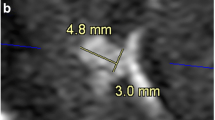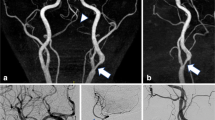Abstract
Objective
To systematically compare time-of-flight magnetic resonance angiography (TOF-MRA) acquired with Compressed SENSE (TOF-CS) to spiral imaging (TOF-Spiral) for imaging of brain-feeding arteries.
Methods
Seventy-one patients (60.2 ± 19.5 years, 43.7% females, 28.2% with pathology) who underwent TOF-MRA after implementation of a new scanner software program enabling spiral imaging were analyzed retrospectively. TOF-CS (standard sequence; duration ~ 4 min) and the new TOF-Spiral (duration ~ 3 min) were acquired. Image evaluation (vessel image quality and detectability, diagnostic confidence (1 (diagnosis very uncertain) to 5 (diagnosis very certain)), quantitative measurement of aneurysm diameter or degree of stenosis according to North American Symptomatic Carotid Endarterectomy Trial (NASCET) criteria) was performed by two readers. Quantitative assessments of pathology were compared to computed tomography angiography (CTA) or digital subtraction angiography (DSA).
Results
TOF-CS showed higher image quality for intraosseous and intradural segments of the internal carotid artery while TOF-Spiral better depicted small intracranial vessels like the anterior choroidal artery. All vessel pathologies were correctly identified by both readers for TOF-CS and TOF-Spiral with high confidence (TOF-CS (4.4 ± 0.6 and 4.3 ± 0.8), TOF-Spiral (4.3 ± 0.7 and 4.3 ± 0.8)) and good inter-reader agreement (Cohen’s kappa > 0.8). Quantitative assessments of aneurysm size or stenosis did not significantly differ between TOF-CS or TOF-Spiral and CTA or DSA (p > 0.05).
Conclusions
TOF-Spiral for imaging of brain-feeding arteries enables reductions in scan time without drawbacks in diagnostic confidence. A combination of spiral imaging and CS may help to overcome shortcomings of both sequences alone and could further reduce acquisition times in the future.
Key Points
• TOF-MRA with Compressed SENSE is superior in depicting arteries at the skull base while spiral TOF-MRA is able to better depict small intracranial vessels.
• Both TOF-MRA with Compressed SENSE and TOF-MRA with spiral imaging provide high diagnostic confidence for detection of pathologies of brain-feeding arteries.
• Spiral TOF-MRA is faster (by 25% for the sequence used in this study) than TOF-MRA with Compressed SENSE, thus enabling clear reductions in scan time for the clinical setting.



Similar content being viewed by others
Abbreviations
- ACA:
-
Anterior cerebral artery
- AChA:
-
Anterior choroidal artery
- BA:
-
Basilar artery
- CS:
-
Compressed SENSE
- CTA:
-
Computed tomography angiography
- DSA:
-
Digital subtraction angiography
- FOV:
-
Field of view
- ICA:
-
Internal carotid artery
- ICC:
-
Intraclass correlation coefficient
- κ :
-
Kappa
- MCA:
-
Middle cerebral artery
- MIP:
-
Maximum intensity projection
- MRA:
-
Magnetic resonance angiography
- MRI:
-
Magnetic resonance imaging
- NASCET:
-
North American Symptomatic Carotid Endarterectomy Trial
- PACS:
-
Picture archiving and communication system
- PCA:
-
Posterior cerebral artery
- PCOM:
-
Posterior communicating artery
- R1:
-
Reader 1
- R2:
-
Reader 2
- SNR:
-
Signal-to-noise ratio
- SUCA:
-
Superior cerebellar artery
- TE:
-
Echo time
- TR:
-
Repetition time
- TOF:
-
Time-of-flight
- VA:
-
Vertebral artery
References
Mozaffarian D, Benjamin EJ, Go AS et al (2016) Heart disease and stroke statistics-2016 update: a report from the American Heart Association. Circulation 133:e38–e360
Volný O, Kašičková L, Coufalová D, Cimflová P, Novák J (2015) microRNAs in cerebrovascular disease. Adv Exp Med Biol 888:155–195
Hart RG, Diener HC, Coutts SB et al (2014) Embolic strokes of undetermined source: the case for a new clinical construct. Lancet Neurol 13:429–438
Nüssel F, Wegmüller H, Huber P (1991) Comparison of magnetic resonance angiography, magnetic resonance imaging and conventional angiography in cerebral arteriovenous malformation. Neuroradiology 33:56–61
Borisch I, Horn M, Butz B et al (2003) Preoperative evaluation of carotid artery stenosis: comparison of contrast-enhanced MR angiography and duplex sonography with digital subtraction angiography. AJNR Am J Neuroradiol 24:1117–1122
Bui TD, Gelfand D, Whipple S et al (2005) Comparison of CT and catheter arteriography for evaluation of peripheral arterial disease. Vasc Endovascular Surg 39:481–490
Cirillo M, Scomazzoni F, Cirillo L et al (2013) Comparison of 3D TOF-MRA and 3D CE-MRA at 3T for imaging of intracranial aneurysms. Eur J Radiol 82:e853–e859
Schernthaner R, Stadler A, Lomoschitz F et al (2008) Multidetector CT angiography in the assessment of peripheral arterial occlusive disease: accuracy in detecting the severity, number, and length of stenoses. Eur Radiol 18:665–671
Mandell DM, Mossa-Basha M, Qiao Y et al (2017) Intracranial vessel wall MRI: principles and expert consensus recommendations of the American Society of Neuroradiology. AJNR Am J Neuroradiol 38:218–229
Chung MS, Jung SC, Kim SO et al (2017) Intracranial artery steno-occlusion: diagnosis by using two-dimensional spatially selective radiofrequency excitation pulse MR imaging. Radiology 284:834–843
Lee NJ, Chung MS, Jung SC et al (2016) Comparison of high-resolution MR imaging and digital subtraction angiography for the characterization and diagnosis of intracranial artery disease. AJNR Am J Neuroradiol 37:2245–2250
Park JE, Jung SC, Lee SH et al (2017) Comparison of 3D magnetic resonance imaging and digital subtraction angiography for intracranial artery stenosis. Eur Radiol 27:4737–4746
Patel MR, Klufas RA, Kim D, Edelman RR, Kent KC (1994) MR angiography of the carotid bifurcation: artifacts and limitations. AJR Am J Roentgenol 162:1431–1437
Kaufmann TJ, Huston J 3rd, Cloft HJ et al (2010) A prospective trial of 3T and 1.5T time-of-flight and contrast-enhanced MR angiography in the follow-up of coiled intracranial aneurysms. AJNR Am J Neuroradiol 31:912–918
Fushimi Y, Fujimoto K, Okada T et al (2016) Compressed sensing 3-dimensional time-of-flight magnetic resonance angiography for cerebral aneurysms: optimization and evaluation. Invest Radiol 51:228–235
Lustig M, Donoho D, Pauly JM (2007) Sparse MRI: the application of compressed sensing for rapid MR imaging. Magn Reson Med 58:1182–1195
Yamamoto T, Okada T, Fushimi Y et al (2018) Magnetic resonance angiography with compressed sensing: an evaluation of moyamoya disease. PLoS One 13:e0189493
Lu SS, Qi M, Zhang X et al (2018) Clinical evaluation of highly accelerated compressed sensing time-of-flight MR angiography for intracranial arterial stenosis. AJNR Am J Neuroradiol 39:1833–1838
Li B, Li H, Dong L, Huang G (2017) Fast carotid artery MR angiography with compressed sensing based three-dimensional time-of-flight sequence. Magn Reson Imaging 43:129–135
Fushimi Y, Okada T, Kikuchi T et al (2017) Clinical evaluation of time-of-flight MR angiography with sparse undersampling and iterative reconstruction for cerebral aneurysms. NMR Biomed 30:e3774
Hutter J, Grimm R, Forman C, Hornegger J, Schmitt P (2015) Highly undersampled peripheral time-of-flight magnetic resonance angiography: optimized data acquisition and iterative image reconstruction. MAGMA 28:437–446
Vasanawala SS, Alley MT, Hargreaves BA, Barth RA, Pauly JM, Lustig M (2010) Improved pediatric MR imaging with compressed sensing. Radiology 256:607–616
Eichinger P, Hock A, Schön S et al (2019) Acceleration of double inversion recovery sequences in multiple sclerosis with compressed sensing. Invest Radiol. https://doi.org/10.1097/rli.0000000000000550
Meyer CH, Hu BS, Nishimura DG, Macovski A (1992) Fast spiral coronary artery imaging. Magn Reson Med 28:202–213
Li Z, Hu HH, Miller JH et al (2016) A spiral spin-echo MR imaging technique for improved flow artifact suppression in T1-weighted postcontrast brain imaging: a comparison with Cartesian turbo spin-echo. AJNR Am J Neuroradiol 37:642–647
Wang D, Zwart NR, Pipe JG (2018) Joint water-fat separation and deblurring for spiral imaging. Magn Reson Med 79:3218–3228
Samuels OB, Joseph GJ, Lynn MJ, Smith HA, Chimowitz MI (2000) A standardized method for measuring intracranial arterial stenosis. AJNR Am J Neuroradiol 21:643–646
Fox AJ (1993) How to measure carotid stenosis. Radiology 186:316–318
Bash S, Villablanca JP, Jahan R et al (2005) Intracranial vascular stenosis and occlusive disease: evaluation with CT angiography, MR angiography, and digital subtraction angiography. AJNR Am J Neuroradiol 26:1012–1021
Kasper L, Haeberlin M, Dietrich BE et al (2014) Matched-filter acquisition for BOLD fMRI. Neuroimage 100:145–160
Ahn CB, Kim JH, Cho ZH (1986) High-speed spiral-scan echo planar NMR imaging-I. IEEE Trans Med Imaging 5:2–7
Heberlein K, Hu X (2006) Auto-calibrated parallel spiral imaging. Magn Reson Med 55:619–625
Zahneisen B, Poser BA, Ernst T, Stenger AV (2014) Simultaneous multi-slice fMRI using spiral trajectories. Neuroimage 92:8–18
Wilm BJ, Barmet C, Gross S et al (2017) Single-shot spiral imaging enabled by an expanded encoding model: demonstration in diffusion MRI. Magn Reson Med 77:83–91
Block KT, Frahm J (2005) Spiral imaging: a critical appraisal. J Magn Reson Imaging 21:657–668
Börnert P, Schomberg H, Aldefeld B, Groen J (1999) Improvements in spiral MR imaging. MAGMA 9:29–41
Pruessmann KP, Weiger M, Börnert P, Boesiger P (2001) Advances in sensitivity encoding with arbitrary k-space trajectories. Magn Reson Med 46:638–651
Wilm BJ, Nagy Z, Barmet C et al (2015) Diffusion MRI with concurrent magnetic field monitoring. Magn Reson Med 74:925–933
Li Z, Karis JP, Pipe JG (2018) A 2D spiral turbo-spin-echo technique. Magn Reson Med 80:1989–1996
Dyvorne H, Knight-Greenfield A, Jajamovich G et al (2015) Abdominal 4D flow MR imaging in a breath hold: combination of spiral sampling and dynamic compressed sensing for highly accelerated acquisition. Radiology 275:245–254
Bane O, Peti S, Wagner M et al (2019) Hemodynamic measurements with an abdominal 4D flow MRI sequence with spiral sampling and compressed sensing in patients with chronic liver disease. J Magn Reson Imaging 49:994–1005
Acknowledgments
The authors of this manuscript declare relationships to Philips Healthcare, whose products and services were related to the subject matter of the article.
Funding
The authors state that this work has not received any specific funding.
Author information
Authors and Affiliations
Corresponding author
Ethics declarations
Guarantor
The scientific guarantor of this publication is Jan Kirschke, MD.
Conflict of interest
The authors of this manuscript declare relationships to Philips Healthcare, whose products and services were related to the subject matter of the article. AH, SH, VG, and MN are employees of Philips Health Systems, Switzerland. JK received research grant from Nvidia, speaker honoraria from Philips Healthcare, and travel support from Kaneka Europe. CZ received speaker honoraria from Philips Healthcare and Bayer, as well as compensation for clinical trials from Biogen Idec, Quintiles, MSD, Boehringer Ingelheim, Inventive Health Clinical, and Advance Cor. TG and NS have nothing to declare.
Statistics and biometry
One of the authors has significant statistical expertise.
Informed consent
Written informed consent was not required for this study because of its retrospective character and the analysis being based only on data acquired during clinical routine.
Ethical approval
Institutional review board approval was obtained (registration number: 1/19S).
Methodology
• retrospective
• cross-sectional study
• performed at one institution
Additional information
Publisher’s note
Springer Nature remains neutral with regard to jurisdictional claims in published maps and institutional affiliations.
Rights and permissions
About this article
Cite this article
Greve, T., Sollmann, N., Hock, A. et al. Highly accelerated time-of-flight magnetic resonance angiography using spiral imaging improves conspicuity of intracranial arterial branches while reducing scan time. Eur Radiol 30, 855–865 (2020). https://doi.org/10.1007/s00330-019-06442-y
Received:
Revised:
Accepted:
Published:
Issue Date:
DOI: https://doi.org/10.1007/s00330-019-06442-y




